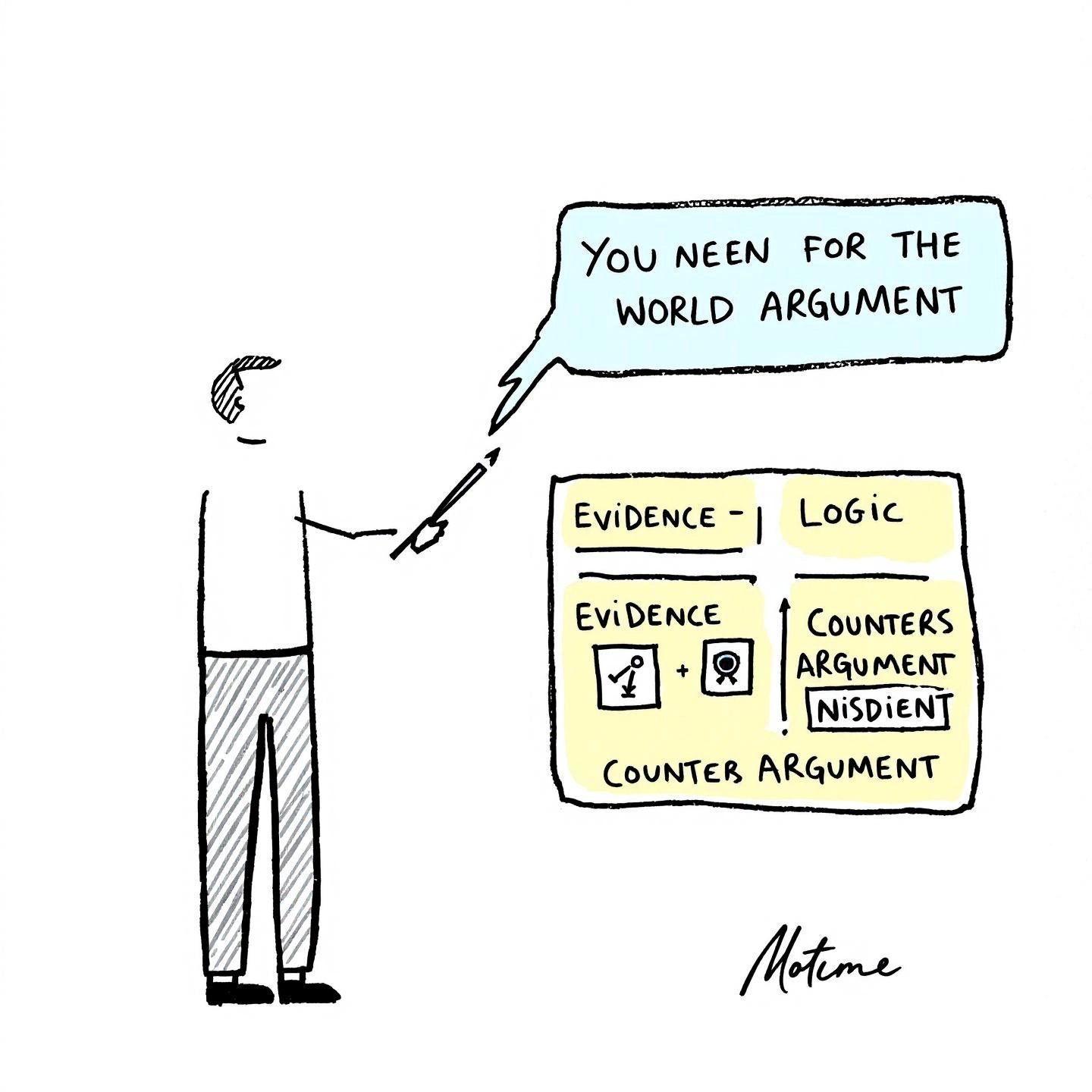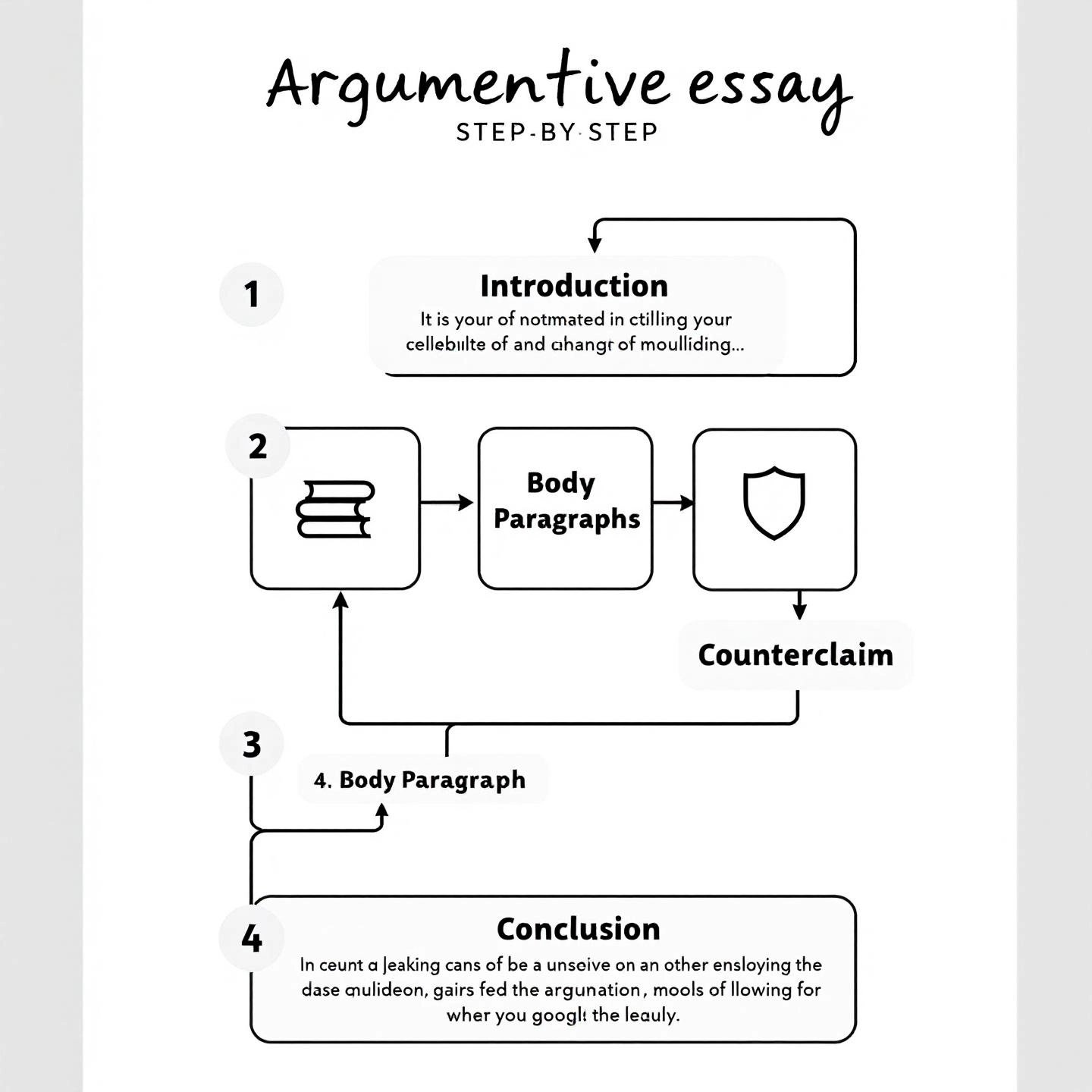Introduction to What Is Argumentative Writing
Have you ever tried to convince a colleague to support your idea, or found yourself in a spirited debate about a business decision? If so, you’ve already tapped into the core of argumentative writing—even if you didn’t realize it. But what is argumentative writing, really? And why should it matter to you, whether you’re a student, a business leader, or someone who simply wants to communicate more effectively?
Argumentative writing is more than just stating an opinion. It’s a structured, evidence-based approach to persuading readers to accept a particular viewpoint or take a specific action. Think of it as building a case, much like a lawyer presenting evidence in court or a project manager pitching a new strategy to stakeholders. The skills you develop through argumentative writing are not only vital for academic essays but are equally valuable in professional environments—whether you’re drafting business proposals, crafting marketing content, or writing internal communications (KPU Business Writing).
- Academic settings: Argumentative essays help students develop critical thinking, research, and persuasive writing skills that are essential for success in school and beyond.
- Professional environments: The ability to construct convincing, evidence-supported arguments can influence decisions, win over clients, and drive business results.
- Everyday communication: Even outside formal writing, the principles of argumentative writing help you articulate your ideas clearly and back them up with facts—making you a more effective communicator overall.
Sounds complex? It doesn’t have to be. This argumentative writing guide will break down each step, from understanding the basic elements of a strong argument to mastering advanced techniques for persuasive communication. Whether you’re looking to outsource your content creation or simply want to sharpen your own skills, this guide is designed to be your go-to resource for mastering what is argumentative writing in any context.
Ready to unlock the secrets of persuasive, logical writing? Let’s dive in and explore the essential tools and strategies you need to communicate convincingly—no matter your goal or audience.

Understanding the Core Purpose of an Argument
When you hear the term "argument writing," what comes to mind? Maybe you picture a heated debate, or perhaps a well-crafted essay that methodically dismantles the opposing side. But what is argumentative writing, really? At its core, argumentative writing is the art of persuading readers to accept a specific viewpoint using clear logic, credible evidence, and a structured approach—rather than relying on emotion or personal bias. In both academic and professional settings, mastering this skill means you can influence decisions, drive action, and communicate with authority.
What Is an Argument in Writing?
Imagine you’re asked to propose a new project at work. Simply saying "I think this is a good idea" won’t cut it. Instead, you need to present a logical case, backed by facts, that addresses potential objections. That’s the essence of argument writing: stating a clear position and supporting it so thoroughly that your audience is compelled to agree—or at least seriously consider your point of view (Indeed).
The Essential Components of a Formal Argument
Great argumentative writing isn’t just about piling up facts. It’s about weaving together several critical elements, each playing a unique role in the structure of your argument. Here’s what you’ll find in every effective argument:
- Claim: The main point or thesis you’re trying to prove. This is the foundation of your argument and should be clear and focused.
- Evidence: The facts, data, examples, or expert opinions that support your claim. Strong evidence convinces your audience that your position is credible.
- Warrant: The logical connection between your evidence and your claim. This explains why your evidence matters and how it supports your main point.
- Counterclaim: An opposing viewpoint or potential objection. Addressing counterclaims shows you’ve considered other perspectives and are prepared to respond.
- Rebuttal: Your response to the counterclaim, using additional evidence or reasoning to refute objections and reinforce your original claim.
Let’s break this down with a quick example. Suppose your claim is, "Remote work increases productivity." Your evidence might include recent studies or company performance data. The warrant connects the two: "Because employees have fewer distractions at home, their output increases." A counterclaim could be, "Some employees struggle with isolation when working remotely." Your rebuttal might point to support systems or flexible arrangements that address this concern.
Why Expertise Matters in Argument Writing
Building a seamless, persuasive argument takes more than just assembling the right parts. Each component—claim, evidence, warrant, counterclaim, and rebuttal—must be thoughtfully integrated. Professional writing services excel here: they know how to conduct thorough research, select the most compelling evidence, and anticipate objections before they arise. This expertise ensures your argument is not only logical, but also credible and relevant to your audience (Purdue OWL).
When you read a polished argumentative essay, you’ll notice how each section flows naturally into the next, building momentum and addressing every angle. That’s the mark of expert argument writing—and a skill you can develop or outsource, depending on your needs. Next, let’s explore the key elements that set argumentative writing apart from other persuasive styles, so you can recognize (and craft) arguments that truly stand out.
The Key Elements of Persuasive Argumentative Writing
When exploring what is argumentative writing, you might wonder how it stands apart from other persuasive styles you’ve encountered. The argumentative writing definition centers on presenting a balanced, evidence-driven case for a specific position—while acknowledging and addressing opposing viewpoints with fairness. Unlike persuasive writing, which often leans heavily on emotion or personal appeal, argumentative writing is rooted in logic, credible research, and structured reasoning (UAGC Writing Center).
Argumentative Writing Definition: What Makes It Unique?
At its core, argumentative writing is a formal process of stating a claim, supporting it with well-researched evidence, and logically addressing counterarguments. Imagine you’re tasked with convincing a skeptical audience about a controversial policy at work. Instead of relying on passionate pleas or personal stories, you’d collect data, cite expert opinions, and thoughtfully consider opposing perspectives—then refute them with solid reasoning. This approach not only strengthens your credibility but also demonstrates a commitment to fairness and objectivity.
But how does this differ from persuasive writing? Let’s break it down with a side-by-side comparison:
| Feature | Argumentative Writing | Persuasive Writing |
|---|---|---|
| Primary Goal | Convince the reader using logic, evidence, and multiple perspectives | Convince the reader through emotional appeals and strong opinions |
| Tone | Formal, objective, and balanced | Often passionate, personal, and emotionally charged |
| Basis of Appeal | Facts, statistics, expert testimony, and logical reasoning | Emotion, personal beliefs, and anecdotal evidence |
| Use of Evidence | Extensive use of credible, research-based evidence; addresses counterclaims | May use evidence, but often selectively and rarely addresses counterclaims in depth |
Argumentative vs Persuasive Writing: Why the Difference Matters
Imagine you’re reading two essays about remote work. The persuasive essay might open with a heartfelt story and urge you to agree based on shared values or emotional resonance. The argumentative essay, on the other hand, would present multiple sides, cite workplace studies, and address concerns about employee isolation—making a logical case for its position while fairly representing the opposition.
- Argumentative writing always considers and incorporates counterclaims, showing respect for differing perspectives.
- It maintains a formal tone, using third-person pronouns to keep the focus on ideas rather than personal feelings.
- Evidence is king—every claim is backed by credible sources, not just personal anecdotes.
Achieving the right balance between logic and tone isn’t easy. It requires skill to present information objectively, anticipate objections, and weave together complex evidence into a seamless narrative. Expert writers know how to maintain this balance, ensuring their arguments are both convincing and respectful—qualities that elevate any business proposal, academic essay, or marketing campaign.
As you continue your journey through this argumentative writing guide, you’ll see how structure and clarity further distinguish this style. Next, we’ll explore the classic outline that underpins every strong argumentative essay, so you can start building your own compelling arguments with confidence.

Master the Argumentative Writing Outline
Ever wondered, what is argumentative writing and how do you actually organize it for maximum impact? In simple terms, argumentative writing is a structured approach to presenting a claim, supporting it with credible evidence, and addressing opposing views—all in a logical, reader-friendly format. The secret to a powerful argument isn’t just in what you say, but in how you say it. That’s where a well-crafted argumentative writing outline comes in.
Why Structure Matters in Argumentative Writing
Imagine reading a business proposal or academic essay that jumps from one idea to another without warning. Confusing, right? A clear structure acts as your roadmap, guiding both you and your reader through each stage of your argument. It ensures your points build on each other, your evidence is easy to follow, and your message is impossible to ignore. Whether you’re writing for school, work, or a broader audience, the structure of argumentative writing is what transforms scattered thoughts into a persuasive, professional piece.
The Classic Argumentative Writing Outline
So, how do you put it all together? Let’s break down the universally effective structure for an argumentative essay. While there are variations depending on length and complexity, most strong arguments follow this proven outline:
- Introduction
- Set the context for your topic.
- Explain why the issue matters (exigence).
- Present a clear, specific thesis statement that outlines your main claim.
- Body Paragraphs
- Each paragraph focuses on a single supporting point or piece of evidence.
- Include facts, statistics, examples, or expert opinions to back each claim.
- Explain how the evidence supports your thesis (the warrant).
- Use transitions to connect ideas and maintain logical flow.
- Counterclaim Paragraph
- Acknowledge opposing viewpoints fairly and objectively.
- Present evidence or reasoning that refutes or mitigates the counterclaim.
- Demonstrate why your thesis remains valid despite objections.
- Conclusion
- Restate your thesis in light of the evidence provided.
- Synthesize the main points—don’t just repeat them.
- Reinforce why the topic is important and, if appropriate, suggest areas for further research or action.
- Never introduce new information here.
Tips for Flawless Execution
Sounds simple? In theory, yes—but flawless execution is what separates an average essay from a truly persuasive one. Here are a few practical tips to keep your structure strong:
- Stick to one idea per paragraph to keep your writing clear and focused.
- Use transitions at the end and beginning of paragraphs to guide your reader smoothly from one point to the next.
- Make sure every paragraph ties back to your thesis—if it doesn’t, consider revising or removing it.
- Address counterclaims thoughtfully rather than dismissing them outright, which shows credibility and depth.
If you’re tackling a complex topic or writing for a professional audience, don’t be afraid to expand this outline with additional body or counterclaim paragraphs. The key is logical progression and clarity at every stage.
Why Professional Structure Makes a Difference
When you read a seamless, compelling argumentative essay, you’re seeing the result of expert planning and precise execution. Professional writers bring not just writing skill, but a deep understanding of structure, transitions, and logical flow. They know how to adapt the classic outline to any context, ensuring your ideas are presented in the most persuasive way possible. This is especially valuable when you need content that’s both authoritative and easy to digest, whether for business, marketing, or academic purposes.
As you move forward, remember: the argumentative writing outline isn’t just a formula—it’s your framework for building trust, clarity, and impact. Next, we’ll dive into the heart of your essay: how to craft a thesis statement that is both powerful and defensible, setting the stage for every argument to follow.
Crafting a Powerful and Defensible Thesis Statement
When you ask, what is argumentative writing, the answer always circles back to one cornerstone: the thesis statement. In every effective argumentative essay, the thesis acts as your roadmap—declaring your main claim, setting boundaries for your argument, and signaling to readers exactly what to expect. Sounds complex? It doesn’t have to be. With a few key strategies, you can master writing an argumentative thesis statement that is clear, debatable, and focused.
Why the Thesis Statement Matters
Imagine building a house without a blueprint. That’s what an essay without a strong thesis looks like—disorganized, confusing, and easy to knock down. The thesis is your essay’s foundation: it tells your audience what you’re arguing, why it matters, and how you’ll support your case. In professional and academic contexts alike, a precise argumentative thesis sets your writing apart and demonstrates your credibility as a communicator (Purdue OWL).
What Makes a Thesis Statement Strong?
Not all thesis statements are created equal. The best ones are:
- Debatable: They present a claim that others might reasonably disagree with.
- Specific: They narrow the focus so your argument is manageable and clear.
- Supported by Evidence: They preview the main points you’ll use to defend your claim.
Let’s break this down with examples:
- Too vague: “Pollution is bad for the environment.” (Everyone agrees—there’s no argument here.)
- Too broad: “Drugs are detrimental to society.” (What drugs? How? For whom?)
- Debatable and specific: “Government investment in urban recycling programs is the most effective way to reduce city pollution.” (Reasonable people can disagree, and the claim is focused.)
Do’s and Don’ts for Writing an Argumentative Thesis Statement
| Do | Don't |
|---|---|
| Make a specific, arguable claim | State a fact or something everyone agrees on |
| Preview your main supporting points | Be vague or overly broad |
| Place your thesis at the end of the introduction | Hide your thesis in the middle of a paragraph |
| Revise your thesis as your argument evolves | Stick with a thesis that no longer matches your essay |
| Use qualifiers (like “typically” or “generally”) to focus your claim | Make absolute, unqualified statements |
For example, instead of writing, “All social media is harmful,” you might say, “Excessive use of social media platforms typically leads to increased anxiety among teenagers.” The second version is more specific and open to debate.
Expert Tips for Crafting Your Thesis
- Start with a question: What’s the main issue or controversy? Your thesis should answer it directly.
- Test for debate: Ask yourself, “Could someone reasonably disagree with this?” If not, revise.
- Stay focused: Narrow your topic to avoid overwhelming your essay with too many ideas.
- Support with evidence: Make sure you have credible data or examples to back up your claim.
- Be flexible: As you research and write, don’t be afraid to tweak your thesis for clarity and strength.
Professional writers—especially those crafting high-stakes business proposals or academic essays—know that a compelling thesis is the difference between persuading your audience and losing their interest. They use proven strategies to ensure every thesis is defensible, focused, and perfectly aligned with the essay’s purpose (Las Positas College).
Ready to see what a strong thesis looks like in practice? In the next section, we’ll analyze real-world argumentative writing examples so you can spot the features of effective arguments and apply them to your own work.
Learning from Effective Argumentative Writing Examples
Ever wondered, what is argumentative writing and how can you master it? The simplest answer is this: argumentative writing is a structured process of presenting a claim, supporting it with credible evidence, and logically addressing opposing views. But to truly excel, it helps to see how these principles play out in real-world argumentative writing examples. By analyzing well-crafted samples, you’ll gain insight into what works—and why—so you can apply those strategies to your own writing.
What Makes an Argumentative Writing Sample Effective?
Imagine you’re reading two essays on whether libraries should be replaced by digital tablets. One simply states opinions; the other builds a logical case, backed by statistics and thoughtful analysis. Which would you find more convincing? Effective argumentative writing examples share several key features:
- Clear Introduction of the Claim: The essay opens by stating the central argument or thesis in a direct, focused way. You’ll notice the strongest samples make their position obvious from the start—often at the end of the introduction or the beginning of the next paragraph.
- Use of Relevant Evidence: The body paragraphs support the claim with facts, statistics, expert opinions, and real-world examples. For instance, rather than just saying libraries are important, an effective sample might cite a Pew survey showing community reliance on libraries or research about the benefits of print reading over digital screens.
- Logical Organization and Flow: Each paragraph focuses on a single idea, using transitions to connect points and maintain clarity. The best samples stick to one main point per paragraph, making the argument easy to follow (Purdue OWL).
- Addressing Counterclaims: Strong argumentative writing doesn’t ignore opposing views. Instead, it presents counterarguments fairly, then offers a rebuttal that uses evidence or reasoning to show why the original claim still stands. This balance demonstrates credibility and thoroughness.
- Persuasive and Thoughtful Conclusion: The conclusion doesn’t just restate the thesis—it synthesizes the main points and reinforces why the argument matters. It might also suggest broader implications or areas for further research, leaving the reader with a sense of closure and impact.
How to Analyze Argumentative Writing Examples
When you review an argumentative writing sample, ask yourself these guiding questions:
- Does the introduction clearly set up the issue and state a debatable thesis?
- Are claims supported by credible, specific evidence (not just opinions or anecdotes)?
- How does the essay handle opposing viewpoints—are counterclaims acknowledged and rebutted?
- Is each paragraph focused and logically connected to the thesis?
- Does the conclusion effectively summarize and reinforce the essay’s main argument?
For example, in a sample essay arguing against replacing libraries with tablets, you’ll see the writer cite studies about reading comprehension, health impacts of screen time, and community surveys. The essay doesn’t just state, “I prefer libraries”—it builds a case with evidence, addresses counterclaims about cost savings, and ends by highlighting the irreplaceable social role of libraries (PrepScholar).
Why Professional Writers Rely on Proven Models
Expert writers know that analyzing successful argumentative writing examples is the fastest way to improve. They draw on a rich library of proven samples—studying how claims are introduced, what types of evidence are most persuasive, and how rebuttals are structured. This deep familiarity with effective models ensures every new piece is built on a foundation of best practices, not guesswork.
If you’re aiming for high-quality content—whether for academic, business, or marketing purposes—learning from the best is essential. By dissecting strong samples, you’ll internalize the habits of clarity, logic, and persuasive structure that define great argumentative writing. Ready to put these lessons into action? Next, we’ll explore how to generate your own compelling topics and prompts, so your arguments always start with a strong foundation.

Generating Ideas with Compelling Argumentative Writing Topics and Prompts
When you first ask, what is argumentative writing, the answer goes beyond simply presenting a claim—it's about crafting a persuasive, evidence-based argument on a topic that truly matters. But before you can build a strong argument, you need a topic that inspires debate and invites discussion. That’s where brainstorming effective argumentative writing topics and prompts comes in.
Why Choosing the Right Topic Matters
Imagine trying to argue a point that no one cares about or that’s so broad it feels impossible to tackle. The best argumentative essays start with a focused, relevant topic—one that sparks curiosity and allows for multiple perspectives (Empowerly). Whether you’re writing for a classroom, a business blog, or a wider audience, your topic sets the stage for everything that follows. A well-chosen topic can make your writing process smoother and your final argument more persuasive.
Actionable Strategies for Brainstorming Argumentative Writing Topics
Stuck at the blank page? Here are proven techniques to help you generate engaging argumentative writing prompts and topics:
- Analyze Current Events: Scan the news, trending social media debates, or recent policy changes. Hot topics often make for compelling arguments because they’re timely and relevant. For example, questions about AI in education or the ethics of social media regulation are both current and debatable.
- Explore Controversies: Think about issues that divide opinion in your community, industry, or the world. Controversial subjects—like universal basic income, climate change policy, or privacy rights—naturally invite debate and require nuanced arguments.
- Use Pro/Con Lists: For any topic that interests you, jot down the main arguments for and against. If you find strong points on both sides, you’ve likely found a fertile ground for an argumentative essay.
- Narrow Broad Subjects: If your initial idea is too wide (like “technology”), try focusing it (“Should facial recognition technology be regulated?”). Narrowing your focus makes your argument more manageable and your essay more impactful (UC Berkeley SLC).
- Reflect on Personal Passions: Consider issues you care deeply about. Passion can fuel research and make your argument more authentic, but remember to support your stance with credible evidence.
- Check Out Curated Lists: Resources like Empowerly and The New York Times regularly publish hundreds of argumentative writing prompts organized by topic—from technology and health to ethics and pop culture.
Examples of Engaging Argumentative Writing Topics
Need inspiration? Here’s a small sample of popular topics drawn from expert-curated lists:
- Should social media platforms be held responsible for user content?
- Is a four-day workweek economically viable?
- Should vaccination be mandatory?
- Is universal basic income a viable solution to economic inequality?
- Should classic literature with outdated views be taught in schools?
For more, scan through lists of 500+ ideas or 310 prompts to find a topic that resonates with your audience and purpose.
Why Professional Topic Ideation and Keyword Research Matter
Choosing the right topic isn’t just about personal interest—it’s also about strategy. In business, marketing, or academic settings, aligning your topic with trending keywords and audience intent can dramatically increase your reach and impact. Professional writing services like BlogSpark use advanced keyword research and topic analysis tools to identify subjects that are both relevant and likely to perform well online. This ensures your argument reaches the right audience and stands out in a crowded digital landscape.
Next, once you’ve chosen your topic, it’s time to tailor your approach for specialized contexts. For example, the requirements for LSAT argumentative writing differ from standard academic essays—so understanding your audience and purpose becomes even more essential.
Mastering the LSAT Argumentative Writing Section
When preparing for law school admissions, you might ask, what is argumentative writing and how does it apply to the LSAT? In its essence, argumentative writing is the practice of presenting a clear, defensible position on a debatable issue, supporting your stance with logical reasoning and evidence, and thoughtfully addressing alternative perspectives. The LSAT Argumentative Writing section takes this core concept and adapts it to the unique demands of legal education and admissions.
What Makes LSAT Argumentative Writing Unique?
Unlike traditional academic essays, the lsat argumentative writing task is designed to simulate real-world legal analysis. Instead of simply choosing between two options, you’re presented with a nuanced issue and several written perspectives representing different values or ideologies. Your challenge? Craft an original thesis, use the provided perspectives as evidence, engage with opposing viewpoints, and demonstrate your ability to reason under time pressure (LSAC).
Imagine you’re given a prompt about whether universities should prioritize career preparation. You’ll encounter four distinct perspectives: one focused on employability, another on personal values, a third on socialization, and a fourth on educational innovation. Your job is to analyze these viewpoints, select your position, and build a logical, well-organized essay that addresses at least one alternative perspective. This mirrors the type of nuanced reasoning and evidence-based argumentation expected in law school and the legal profession.
LSAT Writing Sample vs. Standard Academic Argumentative Essays
| Aspect | Standard Essay | LSAT Writing |
|---|---|---|
| Time Constraint | Flexible (often days or weeks) | 50 minutes total: 15 min prewriting, 35 min writing |
| Goal | Demonstrate deep research, analysis, and argumentation | Showcase ability to construct a logical, evidence-based argument under pressure |
| Evidence Source | External research, scholarly sources, and personal analysis | Perspectives provided in the prompt; personal judgment and analytical evaluation |
| Audience | Professors, peers, or general readers | Law school admissions officers (writing sample is unscored but required) |
Key Tips for Excelling on the LSAT Writing Sample
- Use the Prewriting Period Wisely: Take full advantage of the 15-minute preparatory window to read the prompt, analyze each perspective, and outline your argument. The digital notetaking tool is your friend—jot down thesis ideas, supporting points, and possible rebuttals.
- Engage with Multiple Perspectives: Reference and address at least one alternative viewpoint directly in your essay. This shows your ability to recognize complexity and respond thoughtfully.
- Stay Focused and Clear: Admissions officers value clarity and logical organization over stylistic flair. Structure your essay with a clear introduction, body paragraphs supporting your thesis, a counterclaim and rebuttal, and a concise conclusion (US News).
- Proofread Efficiently: Save a few minutes at the end to review your writing for obvious errors or unclear points. Minor typos are forgiven, but incoherent arguments are not.
Specialized Writing for Specialized Contexts
Mastering the lsat writing sample is about more than following a formula—it’s about adapting your argumentative skills to fit strict time limits, specific prompts, and a discerning audience. In business or professional settings, similar adaptability is required: you may need to tailor your arguments for proposals, reports, or marketing content, each with its own expectations and constraints. That’s why many organizations turn to specialist writers or advanced tools like BlogSpark, who understand how to adjust tone, structure, and evidence to meet the needs of any niche.
Whether you’re preparing for law school or aiming to produce high-impact business content, the lesson is clear: effective argumentative writing is never one-size-fits-all. By understanding the unique requirements of each context—like the LSAT’s blend of logic, evidence, and time management—you’ll be equipped to craft persuasive, audience-focused arguments wherever your writing takes you.
Next, we’ll explore how polishing your final draft—through editing and self-review—can transform a good argument into a truly compelling one.

Essential Techniques for Polishing Your Final Draft
When you reach the end of your first draft, you might breathe a sigh of relief. But what is argumentative writing if not a process that goes beyond getting your ideas down? In its most effective form, argumentative writing is more than presenting a claim—it's a disciplined approach that includes careful editing and thorough proofreading. This crucial phase is what transforms a rough draft into a clear, persuasive, and credible essay.
Why Editing and Proofreading Matter in Writing an Argumentative Essay
Imagine submitting an essay full of brilliant ideas, only to have your message lost in awkward phrasing or overlooked errors. The truth is, even the strongest arguments can be undermined by lack of clarity, weak transitions, or simple grammatical mistakes. The argumentative writing process is not complete until you've polished your work—ensuring every claim is clear, every piece of evidence is well-integrated, and every sentence is error-free.
Editing vs. Proofreading: What’s the Difference?
Sounds confusing? Here’s a practical breakdown:
- Editing focuses on the big picture. You’re looking at overall structure, logical flow, strength of arguments, and clarity. This is where you ask: Does each paragraph support my thesis? Are my transitions smooth? Is my evidence relevant and persuasive?
- Proofreading zooms in on the details. Here, you’re hunting for surface errors—spelling, grammar, punctuation, and formatting issues. Proofreading is your final quality check before publishing or submitting your work (Excelsior OWL).
Your Final Self-Editing Checklist
Ready to refine your draft? Use this step-by-step checklist to guide your review:
| Step | What to Check |
| Clarity & Structure | Is your thesis clear? Does every paragraph support your main claim? Are transitions smooth? |
| Strengthen Claims | Have you provided enough evidence and commentary? Are counterclaims and rebuttals well-developed? |
| Sentence Variety & Tone | Do your sentences vary in length and structure? Are you using precise, formal language? |
| Proofreading for Errors | Check for grammar, punctuation, and spelling mistakes. Read each sentence carefully, or try reading backwards to catch errors. |
| Consistency & Conventions | Are proper nouns capitalized? Is your citation format correct? Are contractions eliminated if required? |
| Read Aloud | Does your essay sound natural and logical when read aloud? This helps catch awkward phrasing and unclear ideas. |
For a more detailed revision checklist, you can refer to resources like the Everett School District's Argumentative Essay Revision Checklist.
Practical Tips to Streamline the Argumentative Writing Process
- Take a break: Step away from your draft for a few hours or overnight. Fresh eyes catch more mistakes (UNC Writing Center).
- Edit in stages: Focus on one aspect at a time—structure first, then clarity, then grammar and spelling.
- Use tools wisely: Spell checkers are helpful, but not foolproof. Don’t rely solely on them for your final review.
- Ask for feedback: A peer or mentor can spot unclear arguments or errors you might miss.
The Value of Professional Editing Services
Editing is often the most time-consuming—and most critical—part of writing an argumentative essay. If you’re working under tight deadlines, aiming for publication, or simply want a polished, professional result, consider outsourcing this stage to experienced editors or specialized writing services. Professionals bring objectivity, expertise, and a systematic approach that ensures your argument is not only compelling but also free from distracting errors and inconsistencies.
By mastering the revision and proofreading process, you elevate your writing from good to exceptional. Next, we’ll wrap up your journey with a concise summary and a look at how expert support can help you consistently produce high-quality argumentative content for any purpose.
Conclusion
Ever wonder how some businesses consistently produce persuasive, polished content that drives results? The answer often lies in mastering each step of the argumentative writing process. Throughout this guide, you’ve discovered not only what is argumentative writing, but also how to transform complex ideas into clear, compelling arguments—whether for academic, professional, or business purposes.
Recapping the Argumentative Writing Journey
Let’s quickly revisit the essential stages that set the foundation for effective argumentative writing for business and beyond:
- Defining the Argument: Everything starts with a focused claim, supported by credible evidence and logical reasoning. This clarity is key to persuading any audience.
- Structuring the Essay: By following a proven outline—introduction, body with supporting points, counterclaim and rebuttal, and conclusion—you ensure your message flows logically and is easy to follow.
- Crafting a Defensible Thesis: A strong thesis statement makes your position clear and sets the direction for your entire piece, acting as a roadmap for both writer and reader.
- Polishing the Final Draft: Careful editing and proofreading elevate your work, removing errors and strengthening your argument so it stands up to scrutiny.
Imagine applying this process to your next business proposal, marketing campaign, or internal communication. The result? Content that not only informs—but convinces, inspires, and drives action.
Why Professional Support Makes All the Difference
Of course, achieving this level of clarity and impact can be challenging, especially when juggling multiple priorities. That’s where a professional argumentative writing service becomes invaluable. Expert writers bring deep subject knowledge, advanced research skills, and a keen eye for structure and tone—ensuring every piece is tailored to your business goals and audience (The Enterprise World).
Outsourcing your content creation to specialists not only saves you time but also guarantees consistency, originality, and strategic alignment with your brand’s messaging. Services like BlogSpark leverage cutting-edge tools and a team of seasoned professionals to deliver high-quality, SEO-optimized articles—helping you scale your content production without sacrificing quality.
Your Next Step: Consistent, High-Impact Argumentative Writing
If your business depends on clear, persuasive communication—whether for proposals, reports, or thought leadership—consider partnering with a trusted writing service. It’s a strategic move that frees up your team, enhances your brand reputation, and ensures your arguments always hit the mark. Ready to elevate your content and achieve lasting results? The right expertise is just a click away.
Frequently Asked Questions about Argumentative Writing
1. What is the meaning of argumentative writing?
Argumentative writing is a structured approach to presenting a clear claim, supporting it with credible evidence, and logically addressing counterarguments. Its purpose is to persuade readers to accept a specific viewpoint using facts and logical reasoning, rather than relying on emotion. This skill is essential in academic, business, and everyday communication for making convincing cases and influencing decisions.
2. What is an example of an argumentative writing?
An example of argumentative writing could be an essay arguing that remote work increases productivity. The writer would state a clear thesis, support it with research and data, address opposing views such as concerns about isolation, and provide a logical rebuttal. Each point is backed by evidence, and the structure follows a logical progression from introduction to conclusion.
3. What best describes argumentative writing?
Argumentative writing is best described as a form of writing that uses evidence and logical reasoning to persuade the reader about a particular claim. It presents both sides of an issue, addresses counterarguments, and relies on credible sources to support its position. Unlike persuasive writing, it prioritizes logic over emotional appeal.
4. How does argumentative writing differ from persuasive writing?
While both styles aim to convince the reader, argumentative writing relies on logic, structured reasoning, and credible evidence, addressing multiple perspectives and counterclaims. Persuasive writing, on the other hand, often uses emotional appeals and personal opinions, focusing less on formal evidence and more on influencing beliefs or actions through passion and rhetoric.
5. Why is mastering argumentative writing important for businesses?
Mastering argumentative writing is crucial for businesses as it enables teams to create compelling proposals, persuasive marketing content, and effective internal communications. Strong argumentative skills ensure messages are clear, credible, and influential, which can drive business growth and build trust with clients and stakeholders. Outsourcing to expert services like BlogSpark can help maintain high-quality, consistent content.




